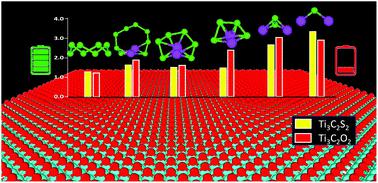Our official English website, www.x-mol.net, welcomes your
feedback! (Note: you will need to create a separate account there.)
Functionalized MXenes as effective polyselenide immobilizers for lithium-selenium batteries: a density functional theory (DFT) study.
Nanoscale ( IF 5.8 ) Pub Date : 2020-06-15 , DOI: 10.1039/d0nr02296a Rahul Jayan 1 , Md Mahbubul Islam
Nanoscale ( IF 5.8 ) Pub Date : 2020-06-15 , DOI: 10.1039/d0nr02296a Rahul Jayan 1 , Md Mahbubul Islam
Affiliation

|
The practical applications of lithium selenium (Li–Se) batteries are impeded primarily due to the dissolution and migration of higher-order polyselenides (Li2Sen) into the electrolyte (known as the shuttle effect) and inactive deposition of lower-order polyselenides. The high electrical conductivity and mechanical strength of MXenes make them a suitable candidate to provide adequate anchoring to prevent polyselenide dissolution and improved electrochemical performance. Herein, we used density functional theory (DFT) calculations to understand the binding mechanism of Li2Sen on graphene and surface-functionalized Ti3C2 MXenes. We used graphene as a reference material to assess Li2Sen binding strengths on functionalized Ti3C2X2 (where X = S, O, F, and Cl). We observed that Ti3C2S2 and Ti3C2O2 exhibit superior anchoring behavior compared to graphene, Ti3C2F2, and Ti3C2Cl2. The calculated Li2Sen adsorption strengths, provided by S- and O-terminated Ti3C2, are greater than those of the commonly used ether-based electrolyte, which is a requisite for effective suppression of Li2Sen shuttling. Ti3C2X2 and graphene with adsorbed Li2Sen retain their structural integrity without chemical decomposition. Density of states (DOS) analysis demonstrates that the conductive behavior of Ti3C2X2 is preserved even after Li2Sen adsorption, which can provide electronic pathways to stimulate the redox electrochemistry of Li2Sen. Overall, our unprecedented simulation results reveal superior anchoring behavior of Ti3C2S2 and Ti3C2O2 for Li2Sen adsorption, and this developed understanding can be leveraged for designing carbon-free Ti3C2 MXene-based selenium cathode materials to boost the electrochemical performance of Li–Se batteries.
中文翻译:

功能化MXene作为锂硒电池的有效聚硒化物固定剂:密度泛函理论(DFT)研究。
锂硒(Li-Se)电池的实际应用受到阻碍,这主要是由于高阶聚硒化物(Li 2 Se n)溶解和迁移到电解质中(称为穿梭效应)以及低阶聚硒化物的无活性沉积。MXenes的高电导率和机械强度使其成为提供适当锚固以防止聚硒化物溶解和改善电化学性能的合适候选者。在这里,我们使用密度泛函理论(DFT)计算来了解Li 2 Se n在石墨烯和表面官能化的Ti 3 C 2 MXenes上的结合机理。我们使用石墨烯作为参考材料评估锂2硒Ñ上官能钛结合强度3 c ^ 2 X 2(其中X = S,O,F,和Cl)。我们观察到,与石墨烯,Ti 3 C 2 F 2和Ti 3 C 2 Cl 2相比,Ti 3 C 2 S 2和Ti 3 C 2 O 2表现出优异的锚固性能。由S和O端接的Ti 3 C 2提供的计算得出的Li 2 Se n吸附强度,比通常使用的基于醚的电解质大,这是有效抑制Li 2 Se n穿梭的必要条件。Ti 3 C 2 X 2和吸附了Li 2 Se n的石墨烯保持其结构完整性,而不会发生化学分解。状态密度(DOS)分析表明,即使在Li 2 Se n吸附后,Ti 3 C 2 X 2的导电行为也得以保留,这可以提供刺激Li 2 Se n氧化还原电化学的电子途径。。总体而言,我们空前的模拟结果表明,Ti 3 C 2 S 2和Ti 3 C 2 O 2对Li 2 Se n的吸附具有出色的锚固性能,这种发达的理解可用于设计无碳Ti 3 C 2 MXene基硒阴极材料可增强锂硒电池的电化学性能。
更新日期:2020-07-09
中文翻译:

功能化MXene作为锂硒电池的有效聚硒化物固定剂:密度泛函理论(DFT)研究。
锂硒(Li-Se)电池的实际应用受到阻碍,这主要是由于高阶聚硒化物(Li 2 Se n)溶解和迁移到电解质中(称为穿梭效应)以及低阶聚硒化物的无活性沉积。MXenes的高电导率和机械强度使其成为提供适当锚固以防止聚硒化物溶解和改善电化学性能的合适候选者。在这里,我们使用密度泛函理论(DFT)计算来了解Li 2 Se n在石墨烯和表面官能化的Ti 3 C 2 MXenes上的结合机理。我们使用石墨烯作为参考材料评估锂2硒Ñ上官能钛结合强度3 c ^ 2 X 2(其中X = S,O,F,和Cl)。我们观察到,与石墨烯,Ti 3 C 2 F 2和Ti 3 C 2 Cl 2相比,Ti 3 C 2 S 2和Ti 3 C 2 O 2表现出优异的锚固性能。由S和O端接的Ti 3 C 2提供的计算得出的Li 2 Se n吸附强度,比通常使用的基于醚的电解质大,这是有效抑制Li 2 Se n穿梭的必要条件。Ti 3 C 2 X 2和吸附了Li 2 Se n的石墨烯保持其结构完整性,而不会发生化学分解。状态密度(DOS)分析表明,即使在Li 2 Se n吸附后,Ti 3 C 2 X 2的导电行为也得以保留,这可以提供刺激Li 2 Se n氧化还原电化学的电子途径。。总体而言,我们空前的模拟结果表明,Ti 3 C 2 S 2和Ti 3 C 2 O 2对Li 2 Se n的吸附具有出色的锚固性能,这种发达的理解可用于设计无碳Ti 3 C 2 MXene基硒阴极材料可增强锂硒电池的电化学性能。











































 京公网安备 11010802027423号
京公网安备 11010802027423号